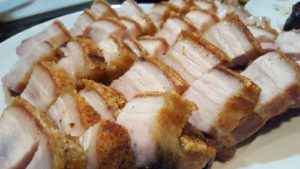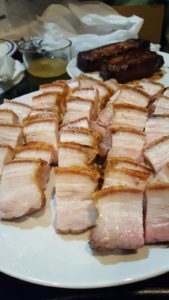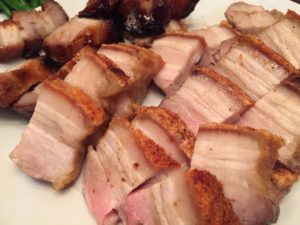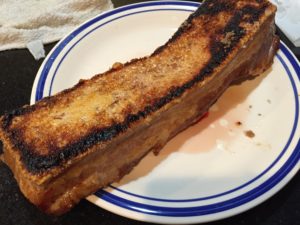
Only here in the U.S. am I blogging on New Year’s Day. It’s the first day of the Chinese lunar new year and I’m breaking all the rules.
We aren’t supposed to be working…it’s a holiday. That means no cleaning and sweeping, cooking and slicing (using of knives.) No cutting hair, or doing business. Time to celebrate!
In China people take weeks off to return to their home village to celebrate. In Singapore we sometimes enjoy four days of holidays. Or at least two official days. New year’s eve dinner is the big home cooked meal held in the partriach’s home and we wait around playing mahjong (not I) or other games to herald in the new year.
Chinese New Year is celebrated over two weeks. Which means you continue to greet each other with NY salutations for the period, and we married folk continue to give children and unmarried folk red packets containing money.
Traditionally, on new year’s day we wake up, don our festive new year (red) clothes, eat some sweet dumplings and leen gou (sticky rice patties) and be out and about visiting our parents or grandparents. Except, we’ve become the parents and grandparents now. My kids aren’t here in this area.
But hey, I’m in Virginia and it’s a regular work day. So, I already did my usual routine. Up for gym, then run to the store to get some grocery, shower, eat some cereal, and wait for my contractor to come talk about a door. Happy New Year America style!
Blessedly there are some traditions kept. On Saturday we started new year celebrations with my neighbors, who hosted a hotpot dinner.
Then last night for new year eve’s dinner we observed it with our foreign service family. Most of us have retired in the DC area. The guys hail from different parts of the US and the wives are from Taiwan and Hong Kong. Together this group has spent hundreds of years serving this country in the China area. We all met in Taiwan back when in the early 80s; some of us had no kids then and now some of us are grandparents.

My contribution was traditional Chinese pork barbecue, a popular dish for festive occasions. Roasted meats include duck, pork shoulder, and the yummiest, pork belly! I did both Siu Yoke ( pork belly,) and Char Siu, made with CT butt, or pork shoulder.
Today I’m going to focus on Siu Yoke, roasted pork belly.
 Siu Yoke, Roast Pork Belly
Siu Yoke, Roast Pork Belly
Siu Yoke is cooked with belly pork with the skin intact. The crispy skin is the most delicious part. In China and Taiwan pork belly is called wu hua ro (five-flower meat) because of its alternating layers of fat and lean meat which usually averages about 2½ inches (7-8 cm) thick. The Chinese in Singapore call it three-layer meat, san ceng ro.
Traditionally you roast a whole side of the pork belly. But in Chinese markets here in the U.S. most slabs are cut about 3 inches (8 cm) wide by 8-9 inches (20-22 cm) long. Pick one that is well marbled with some meat and not too much fat. If ribs are in it, debone it.
In Korean supermarkets the pork belly is sold in narrower strips. This is great too because then more of the surface of the strip is exposed giving it more crispy surfaces!
I first learnt how to make this from Ava, a very plucky woman from Guangzhou who had swum her way to freedom from China to Macau. She lived in Taipei when Ted and I were there and at the time, there weren’t any places in Taipei that we knew sold Siu Yoke.
If we were living in Hong Kong, I don’t think I would have learnt how to do it because it’s sold in so many places.
Since then I’ve tried ways other friends make Siu Yoke, settling on my own version below. The common secret to getting crispy skin is covering it completely with salt and roasting it at high heat at the last moment of cooking until the skin crackles.

Sui Yoke (Cantonese Roast Pork Belly)
3 pounds (1½ kilos) belly pork with skin on, about 1½-2 inches wide
Salt, preferably rock salt or kosher salt
Marinade
1½ teaspoons five-spice powder
1½ teaspoons table or rock salt
3 teaspoons Xiaoxing or rice wine (optional)
In a bowl, blend five-spice powder and salt with rice wine. Wipe the surfaces of the pork dry. Smear the marinade liberally over the meat, taking care not to let the marinade touch the skin of the pork. Marinate pork skin side up on a roasting rack at room temperature for at least 30 minutes.
Move oven rack to center of oven. Preheat oven to 400 degrees F (210 degrees C.)
Dry thoroughly with paper towels before cooking or skin of the pork will not get crispy. Place meat on rack over a baking tray so that the skin is facing up. Make sure the top surface is flat and leveled.
Sprinkle salt over the skin of the pork, covering the skin completely. Place hand or side of knife at the side of the pork to prevent the salt from slipping off. And no, the Sui Yoke is not going to be salty.

Roast at 400 degrees F (210 degrees C) for about 15 minutes.
Lower temperature to 275 degrees F (135 degrees C) and cook for another 15 minutes. Check for doneness with food thermometer by inserting into the lean, not fat, of the meat. Temperature should reach 145 degrees Fahrenheit (62 degrees Celsius.) If it is not done, bake for another 10 minutes.
When pork is done, scrape away the salt from the top of the slab. Move oven rack to top rack.
Adjust heat to broil on high. Return pork to oven still with skin facing up. Broil for 3-5 minutes, leaving oven door slightly ajar. Keep a close watch at this point to prevent it from burning, When the complete surface of the skin in crackling golden and bubbly, remove from oven.
Let meat stand to cool uncovered for at least 20 minutes.

Slice meat just before serving. Turn Siu Yoke on to its side and with a sharp knife, slice the meat neatly, taking care to make a clean cut through the crispy skin.
Notes:
–Do cover the skin completely with a generous layer of salt.
–Meat may be marinated a day ahead. Dry it unwrapped in fridge. To prevent contamination keep pork away from fresh fruit, vegetables or other foods. Let meat stand at room temperature for at least 45 minutes before roasting. If meat sweats, dry it just before cooking.
–Wider cuts: If using pork belly that is 3-4 inches wide, increase the roasting time of 275 degrees F (135 degrees C) by 10 minutes. Check earlier to see if pork is done.
–If your oven doesn’t have a broil function, raise temperature to 525 degrees F (273 degrees C) to singe the pork skin at the end.
WHAT GETS TRICKY: Watch the final crisping at high temperature closely to get the skin completely crisp and not charred. Some parts of the skin may take longer to bubble. If parts of it get burned black, don’t worry. After it cools, scrape off the black bits over the sink with the back of a knife until it exposes the nicely brown skin. Like burnt toast, it comes off easily. The Siu Yoke will look beautiful and still taste crispy.
–Do not cover roast when cooling it on the counter as it will trap moisture and cause the skin to get chewy. When making this for potluck, do not put it in a covered container. Transfer it whole uncovered and cut into pieces just before serving.
Variations
Different seasoning:
In Guangzhou, I’ve had Siu Yoke that had only the slightest touch of marinade (no five-spice, just a little wine and salt) and it was delightfully subtle.
Banquet Presentation
Plating Cantonese Roast Meats:
There are different ways to present this great piece of meat.
–My friend Vivien Woon roasts a large slab of pork belly—4 pounds (2 kilos). Just before serving, she chops it into large-serving chunks which you can sink your teeth into. Nom nom!
–If you like the savory flavor and crusty texture on the end cuts of roasted meat, cut the pork belly into narrower widths to get more surface area and crusty sides before roasting. Pork belly in Chinese supermarkets is usually sold in a rectangular brick shape, usually about 8 inches (20 cm) long, like the length of bacon, with varying widths. Instead of one large slab of meat, cut it into two-inch wide slabs, keeping its length, and roast two or three narrower slabs. This way, when you slice it for serving, each slice with have tasty, crusty sides.
–When setting them on a dish, cut them into regular widths and line neatly on a long plate. You can slice them thinly, ⅓ inch (1 cm) wide, and have them laying flat down. Or you can cut them in thicker chunks, 1¼ inch (3-4 cm) thick, and have neatly lined but sitting upright on a platter.
Garnish:
–Present Sui Yoke on its own on a dish. Serve with a dipping sauce (Oyster Sauce With Hoisin Sauce on Page XX). Or drizzle dipping sauce around the Sui Yoke.
–Garnish with cilantro, or store bought Japanese pickled daikon. Place these to the side of the Sui Yoke, not on top. The Sui Yoke should be the central focus.
In Guangzhou they love to garnish with orchid and I’ve seen them do this with Char Siu Sui Yoke. I have no idea if orchids are edible and don’t put anything on a plate unless I know I can eat it.
–At the White Swan Hotel, where we lived for two years in Guangzhou, one of their many restaurants presented Sui Yoke neatly cut into small blocks of meat, without any crispy end cuts! It was a beautiful presentation, the crispy skin contrasted with the white fat and succulent meat, but that meant the tasty, roasted sides were sliced off. I wonder who got to eat those tasty bits.


Looks delicious!